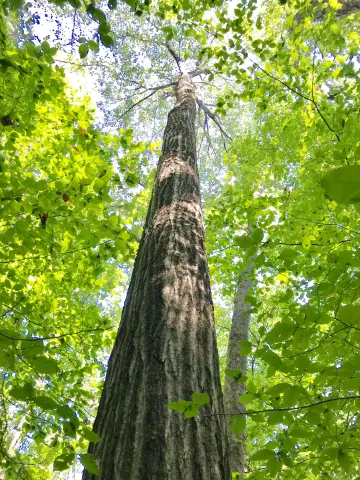Plant Miracles

By Steve Roark
Volunteer Interpreter, Cumberland Gap National Historical Park
The more I learn about plants the more I realize they are not the inanimate life forms they seem to be. Yes, animals are cool with the leg and wing thingees that allows them to move about and get our attention. But plants now, plants stand there quiet all day long and perform a miracle: they make things appear out of thin air.
The miracle I am referring to is photosynthesis, that amazing chemical process powered by sunlight that produces everything you see in the woods (trees, moss, wildflowers) out of air. Well, to be more precise, out of carbon dioxide and water vapor floating around in the air. Here is my best shot at explaining something that involves many of steps and thousands of chemical reactions. Plant leaves takes in air through tiny port holes called stomata. Using the sun as a power drill, it disassembles the water molecules, saving the hydrogen atoms out of them and discarding the oxygen atoms back into the air. This alone is very cool because we get to breathe. Using the same solar power tool, the plant rearranges the carbon and oxygen atoms in carbon dioxide molecules, sticking in those hydrogen atoms from the water. The final product is a long chain of a very versatile organic compound called a polysaccharide (I had to sneak in at least one technical word). You know this compound more commonly as a carbohydrate, which by definition is an organic compound made of carbon, hydrogen, and oxygen.
The beauty of these polysaccharides is that they can be used by plants in two important ways: storage or structure. Arrange the atoms a certain way and you get sugars such as glucose and fructose, which can be stored and then metabolized as needed for food energy by the plant (and us if we eat the plant). Arrange the atoms another way and you get a structural material called cellulose, which is found in plant cell walls. It makes the cell rigid and allows plants and especially trees to stand tall. Cellulose is probably the most common organic compound on the planet with about 33% of all plant matter being cellulose. Tree wood is around 50% cellulose, and cotton fiber is 90%. We humans take great advantage of cellulose and its structural qualities, using it for building material, paper, cardboard, clothing, and thousands of other uses.
Does knowing how photosynthesis works make it less of a miracle? In college I once saw a poster showing all the processes involved with photosynthesis. It covered half the wall and showed hundreds of chemical reactions. If just one of those reactions failed to take place, there would be no forest, no fresh salad, and no porterhouse steak. So yes, it’s a well-designed miracle we need to remember to be thankful for.
- Log in to post comments